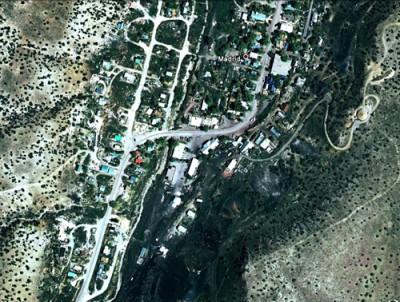Moving Images Part 1- Gobs of Fun!
I sometimes envy landscape architects – they have some pretty clear problems to solve, and everyone likes plants. But one of the benefits of working at a large multidisciplinary design firm is that I can wander around the office and see what my colleagues are up to. Since we all speak the language of design we can usually talk pretty coherently across disciplines. I get to live the life of a landscape architect vicariously, but still escape at a moment’s notice when the going gets rough.
Last week, Landscape Architect Ken Romig introduced me to a project he is working on in Madrid, NM, a former mining town in the Ortiz Mountains near Santa Fe. Madrid’s coal mines shut down decades ago, and starting in the 1970’s the land and the mining shacks were sold in parcels to folks who wanted to live in a relatively isolated village community. Those buyers have been refining a sense of community here ever since; you can get a taste of its texture in the last scene of the motorcycle comedy “Wild Hogs”, although the actual residents are quite a bit more diverse. Unpainted mining shacks have been repainted and repurposed as galleries and cafes, while other traces of the mining operations remain unchanged, particularly the gob piles.
Gob is a low grade coal waste, and in Madrid it appears as a series of black hills by the side of the road, towering above rooftops in some locations. It blows around a bit in the windy season, and gives the town a tired, dusty aura. Since Madrid is listed as an Historic District by the National Parks Service, these nasty hulking masses are actually considered to be contributing assets to the historic fabric of the village, and they must be treated with a certain amount of reverence. Pretty weird really.
The problems are many: dust, erosion, the site of the black hills themselves, and possible contamination of water sources. But the consensus seems to be that these gob piles are an asset. They contribute to the sense of Madrid as a unique place with a unique history. Some residents are disappointed with previous remediation attempts, where piles were fenced off and redistributed, seriously altering their character and leaving things uglier than before. There is a mining museum in town, and mine shaft tours are being contemplated, so the gob piles certainly add realism to all this. But the problems are real and need to be addressed, and moving the gob piles is probably not an option – they are just too big!
The funding source for all past and proposed remediation projects is the New Mexico Abandoned Mine Land Program, where federal funds are allocated for the remediation of former mining sites. The solutions, from soil amendments and plantings to containment structures, or even interpretive signage and displays to make the sites into a sort of mining theme park, are for the residents of Madrid to decide. Ken would leave them as is, seeing beauty in an historic landscape, and focus instead on problems like drainage and erosion that are the result of turning a temporary mining operation into a permanent town. The next phase will be identifying and prioritizing these projects, and it will be interesting to see how things shake out. But here is where I leave off and go back to the building design at my desk -the identity of an entire community is more than I can handle today!
New Mexico Abandoned Mine Land Program
http://www.emnrd.state.nm.us/MMD/AML/AMLmain.htm
Madrid
http://www.visitmadridnm.com/index.htm
Wild Hogs
http://www.imdb.com/title/tt0486946/



Comments
Hazardous Waste = History?
I definitely think it's quite ironic that if a pile of noxious coal mining waste stands long enough it can become historically significant. I wonder if it is more important to the people of Madrid to remediate the gob piles or to be reminded of the hazardous local history of coal mining.
Please read the report
As the technical lead and senior scientist for the Madrid project, I strongly recommend you read the report before coming to any conclusion. You can find it at www.madridmininglandscape.org
The laboratory testing indicates the gob piles/coal wastes in Madrid are not toxic. Their chemistry is essentially no different than the sedimentary outcrops that contain coal throughout the valley. In my 15 years of work reclaiming coal mines in the NM, I have seen very few areas that are truly "toxic". The gob generates dust when the wind blows, but probably less dust than the large areas denuded for the suburban sprawl on the West Mesa. The gob piles also contribute to localized issues with stormwater and erosion. But so do antiquated building codes requiring huge, oversized parking lots that increase stormwater runoff. Makes you wonder?!
I suggest you view the landscape with the eyes of someone who lives in the community rather than the more "gentrified" eyes of us outside of Madrid. Brett said it well: "They (the gob piles) contribute to the sense of Madrid as a unique place with a unique history." If some residents have an affection for the historical landscape that includes mining disturbances and gob piles, who are we to judge?
The planning process will ideally involve the discussion of the gob piles, their historical value and what piles contribute to environmental problems. Then a decision may be made by the community, AML and the stakeholders regarding possible remediation activities, if any. They may also choose to leave them be. That may be weird to an outsider, but then again, we don't live there.
Thanks
Doug,
Thanks for your response and link to the report. I've read the summary and I can see that finding an answer that is acceptable to the residents won't be easy. You're also right that my "gentrified eyes" don't fully appreciate how the gob piles contribute to make Madrid unique. That said, I'm still interested to see what comes of this process. Good luck to you and everyone in Madrid.